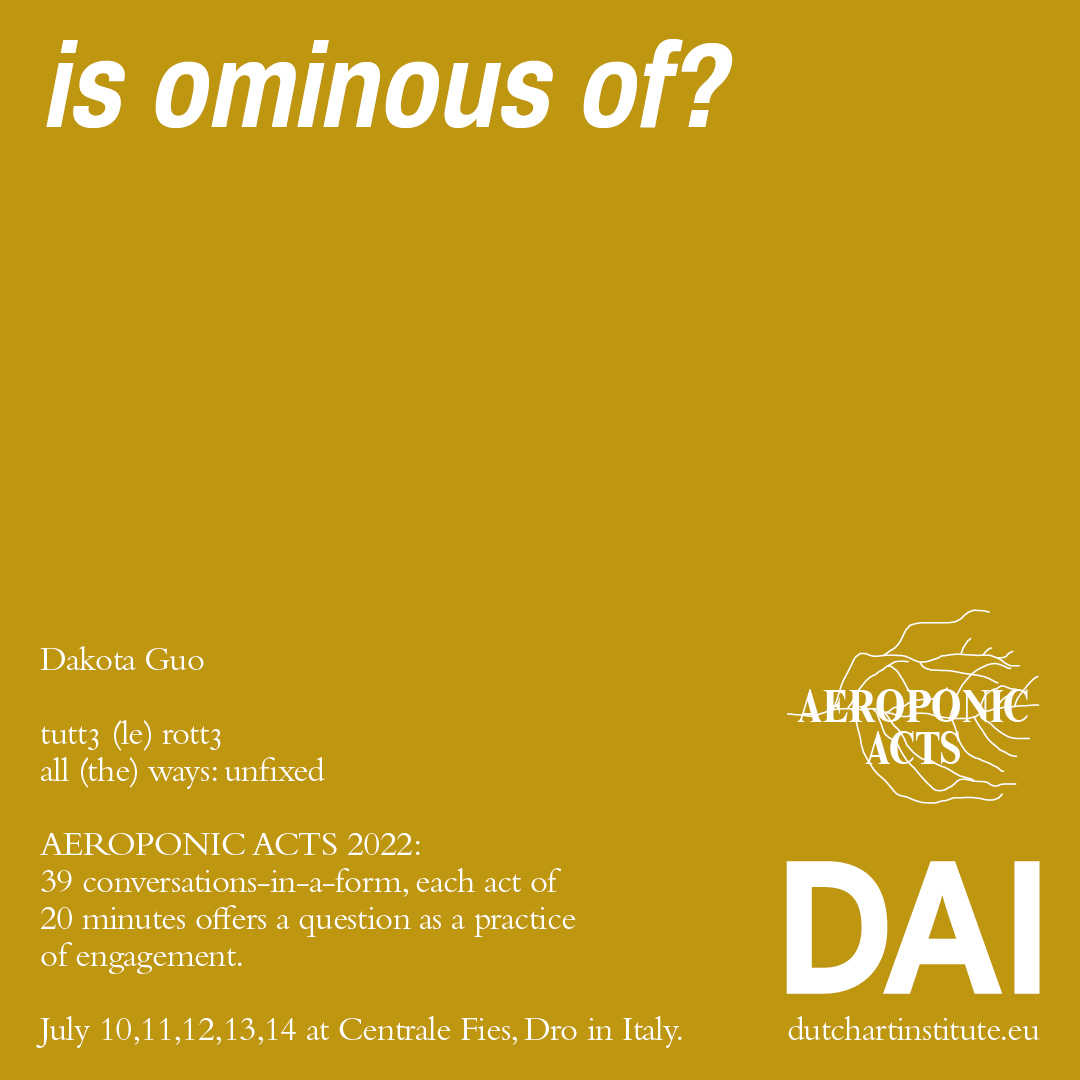Dakota Guo: is ominous of?
‘Aeroponic’ – root systems nourished by air – Acts is the name given to the nomadic Dutch Art Institute’s final Kitchen presentations. Each participant addresses one question, as a practice of engagement.
Here you will find the documentation of Dakota Guo's presentation as filmed by Baha Görkem Yalım. The written report is by Hubert Gromny and it includes a summary of the comments by esteemed guest respondents.
VIDEO COMING SOON
is ominous of?
Dakota's question: is ominous of?
Dakota's introduction: A symbol is the feet of a duck that remind you of duckness. An omen is a clear water that submerges the feet of a duck, and there, it suspends.
I take (false) etymology as a morgue for corpses that have fallen off signification, but I sigh for the portended that has been prescribed ahead of future references. Omens are to be taken literally.
Hubert's report: The pillows and chairs are distributed in a bright space creating a semi-stage setting. In front two TV screens are placed on the metal stands presenting text and video footage interchangeably. There is a bowl of soup located in their proximity. Dakota and other performers (Miyoung Chang, Miiel Ferráez, Iga Świeściak, Cristina Emmel) are sitting together with the audience. The text presented on TVs tells the story of the mythical figure Meng Po—a goddess of forgetfulness, who awaits for the souls of the dead at the river of oblivion to offer them a duck soup. The soup enables them to forget and erase their memories in order to reincarnate without burdens of the previous life. The story is interpreted and presented within the text and videos as a part of the broader economy of the dead and the living. The subtitles are often interrupted by the footage presenting ducks swimming in a pond, close ups to hands presenting figurative gestures but also browsing shelves in the Asian market “Amazing Oriental” in Rotterdam in search for a duck soup. At a certain point of the presentation Dakota stands up and carries an empty bowl. She approaches the member of the audience sitting next to the pot with the soup. The audience member is pouring the soup into Dakota's bowl which appears to be leaking while being carried in ceremonial fashion. Other performers gradually join the presentation in repeating the gesture of Dakota— they stand up, ask for the soup, carry it and spill it leaving traces on the floor. Some of them retire on the side sitting on the floor, others engage with different choreographies—moving in circles or continuing walking within the audience. The video footage and text are shown on the screen continuously during the whole presentation. The end of the videos marks the end of the presentation.
Momtaza Mehri commented on the density of the work—on how many different elements are exposed at once to one gaze. The videos showing erratic images, jerky movements of the duck, the hand guiding through shelves of the supermarket, and performative gestures of carrying the bowl invoked thick symbology of the piece. As such the work seemed to be stabilizing itself on few grounds—human, non-human, animal and ghostly grounds. Despite the density, which resulted in fragmentation of the gaze, the narrative with a central character allowed the audience to follow a main story, which was told in a modality of the riddle. Momtaza spoke about the etymology of the word ‘ominous’, which evokes the future events and noted that the work has a lot to say about the past and as such incorporates healing within its temporality. At the end of the response Momtaza suggested that delving into the relationships between the hands and ducks presented in the video, could emphasize the transitory character of the dimension between life and death thematized by the performance.
Ana Teixeira Pinto focused on the main mythological figure of the piece—Meng Po and shared her interest in stories and characters, who became spirits and demons by not being able to come in terms with grief. In this case, Meng Po became a deity watching over the underworld and cooking a soup allowing souls to forget and move on to their future lives without carrying the ghosts of the past. Ana observed that a trope of such characters, who became deities because of their inability to let go of the past is present in various cultural contexts. Usually these are female figures, who are grieving because they were wronged during their mortal lives. Such stories are in a way acknowledgment of a position of the woman in society, who are pre supposed to be wrong and are meant to suffer and be burdened with injustices even in the afterlife. Ana pointed out that entanglement of remembrance and forgetfulness are representing the space of haunting as a space where horror and history are interwoven and calling for an investigatory mode of reading the past.
Phanuel Antwi shared the feeling of being lost due to the density of symbols and various temporalities introduced by the film and performance. The form of the work was asking for and not allowing to be multiply present at the same time—creating a specific experience of forgetting and remembering during the time of the presentation. Phanuel pointed out that the grammar of the work is not giving an easy entry point for the viewer as it deals with mythology, which is fictionalized and narrated in a very fluid way, making it uneasy to navigate without being familiar with the myth. Nevertheless the work by balancing on different scales and values of the body commented on the labor of affective memory and posed the question of the governance over the dead by collapsing certain economic and spiritual notions.
Dakota Guo's "is ominous of?" was presented before live audience at the Centrale Fies, Dro, Italy on July 10th.
Find the overview of all 24 AEROPONIC ACTS 2022 here: tuttə (le) rottə - all (the) ways: unfixed


